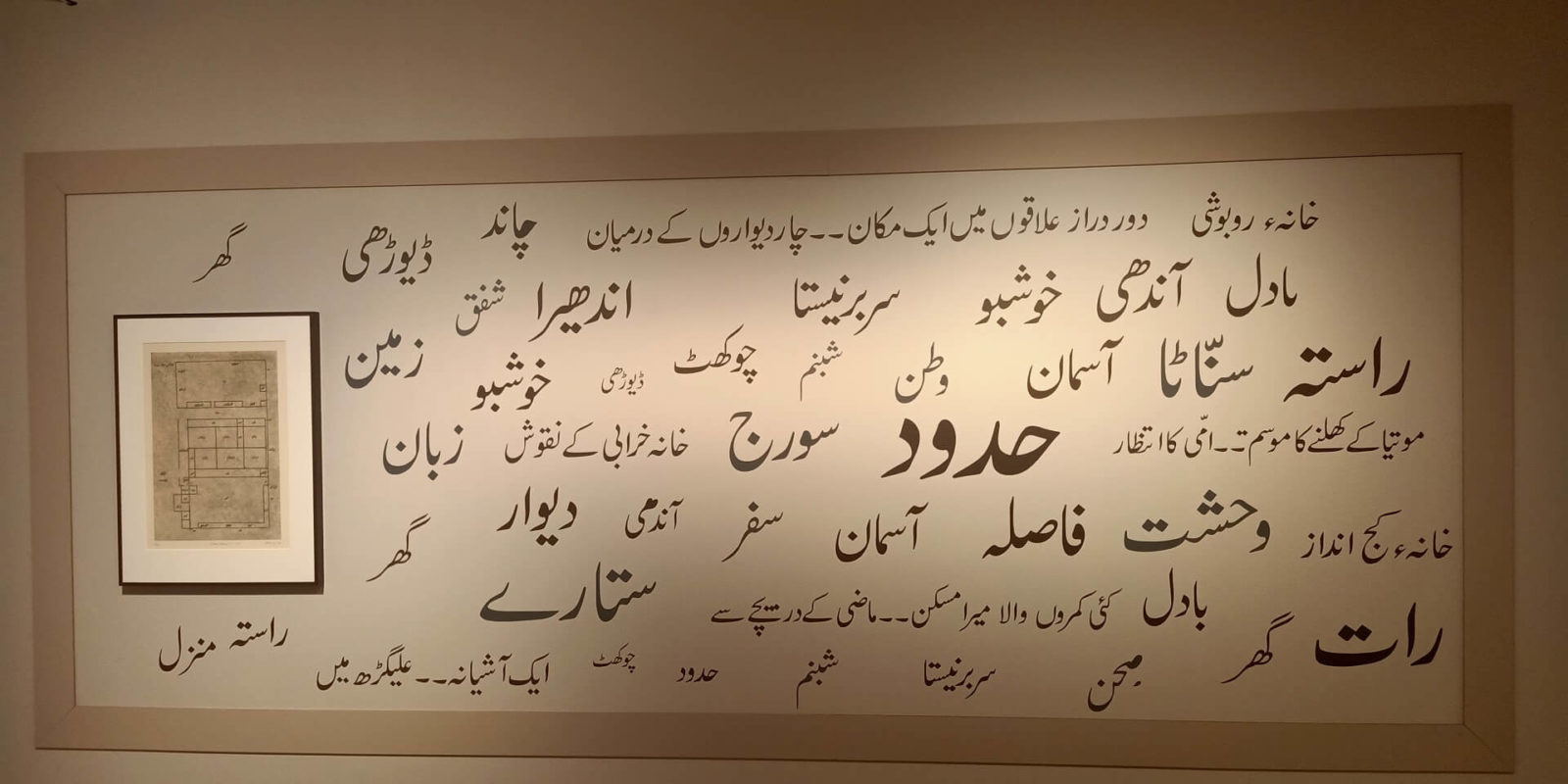Kiran Nadar Museum of Art present Scripting Time: Memory: Ecology and Right to laziness…no, Strike that! Side walking with the man saying sorry.
Begins from: 30th January 2020
At KNMA, Saket
From: 10.30 am – 6.30 pm
On till: 30th June 2020
New Delhi, 27th February 2020: The Kiran Nadar Museum of Art opens the season with four exhibitions, of which a primal design allies three exhibitions with Scripting Time | Memory | Ecology curated by Roobina Karode. The triad consists of around 160 artworks belonging from different stages and artistic careers of seven women artists.
The curatorial position of Scripting Time | Memory | Ecology puts into perspective an alternative narrative, removed from a parochial art historical mapping of abstraction as a forte circumscribed to practices of male artists. Paths of creative representation of memory and ecology assumed in relation to time weaves a common thread among the artists.
The exhibitions, Zarina: A Life in Nine Lines, Across Decades – Borders – Geographies;
Line, Beats and Shadows: Ayesha Sultana, Prabhavathi Meppayil, Lala Rukh and Sumakshi Singh and Abstracting Nature: Mrinalini Mukherjee and Jayashree Chakravarty revisits and engages with a gamut of languages of abstraction. In all three expositions, configurations are built out of drawings, prints in woodcut, etchings, lithographs, aquatints, collages, paper casts, metal casts, installations, gesso work, and sculptures in a range of mediums as varied as bronze and lace embroidery. These artworks from the KNMA collection, loans from artists, artist’s estates, galleries and private collectors are exhibited in a pattern that interconnects and strikes a conversational relation amongst the diverse practices of the artists. “The exhibitions showcase works of seven women artists, whose personal experiences and generational differences spanning numerous decades mark the key moments in the long and troubled durée of South Asian history. Providing a spectrum of artistic languages varying from the abstract and allusive to the quasi-representational, these works gracefully move between the spiritual and political, the frugal and exuberant”, says curator of the exhibitions Roobina Karode.

Zarina: A Life in Nine Lines | Decades – Borders and Geographies is a solo show dedicated to the artistic career of Zarina Hashmi. Primarily exploring the medium of paper and her fascination towards it, the exhibition displays woodcut prints, lithographs, etchings, paper and metal cast works along with sculptural objects. Her life fraught with migration, fascination for architecture and symmetry and interaction with varied cultures shape the themes, techniques and methods in her works. The trauma of Partition and pain of un-belongingness take complex existential dimensions, through an evolved minimalism that takes history as its point of departure. Absorbing the intensity of longing to return to an origin, and transforming the desire into a poetically minimal visual language, Zarina conjures ideas around ‘home or homeland’, which recall different times lines, places and emotional states where home is often imagined in the form of nostalgia, relationships and geographies. For instance, set of thirty-six woodcut and letterpress prints, home is a Foreign Place (1999) indicates an emotive phrase of un-belonging, where linear suggestions of a floor plan and changing phases of the moon on an axis unfold as fragments of memories. Whereas nostalgia initiated an etching, Hometown (1987), shows a subtle dividing plane that defines the earth and the sky, with pointed peaks reciprocating on both sides.

The show Line, Beats and Shadows presents artists Ayesha Sultana, Prabhavathi Meppayil, Lala Rukh and Sumakshi Singh and their eclectic interpretation of abstraction. Ayesha Sultana masquerades fragile paper as metal, her aesthetics drawn from the visuals of Dhaka’s shantytowns marked by disparate class conditions. On the other hand, Prabhavathi Meppayil’s works of iron and brass objects and gesso panels, marked by an economy of means harmonizes modernist practices with a reinterpreted artisanship of goldsmiths in southern India. Sumakshi Singh uses the aspects of nostalgia and memory to recreate domestic architecture using lace embroidery. In place of brick and mortar, the fragile space breathes a new life, as people inhabit the space while engaging with spectral cobwebs of past memories. Encapsulating Lala Rukh’s parallel photographic practice are a suite of six works on display, which were recorded during Lala’s travels across South Asia between 1992 and 2005. Laced with minimalism, a philosophy that she carries throughout her studio practice, each series of small works reflect time-captured tranquil topographical views of water bodies, devoid of people or beings.

In the show Abstracting Nature with Mrinalini Mukherjee and Jayashree Chakraverty there is a complimenting approach where they amalgamate the myriad objects, images and ideas extracted from nature into their own oeuvre, both as an abstract and in a cryptic visual language. For the first time perhaps, viewers engage a corpus of drawings, etchings and watercolor produced by Mrinalini Mukherjee who stands distinctly alone as a sculptor known for her hemp sculptures. Seeking solace in the serenity of nature deeply resonates with both the artists’ practice and philosophy. For Mrinalini, it was through her soft sculptures composed of fiber, she successfully appropriated weaving or knitting on a massive scale with an independent vocabulary to create her own artistic idiom.
The suite of monochromatic works consisting of etchings and watercolor works from the museum collection dates back to Mrinalini’s early decades of her art practice. Renditions of disparate landscapes in motion through swift strokes in Storm (1984), View (1983), Moonlit Walk (1982), Path (1983) and bronze sculpture series Palm Scape from the museum collection are on display among others.
For several decades now, Jayashree’s preoccupations and concerns in her practice have largely addressed the shrinking of natural habitat and water bodies in ever-expanding Indian cities. She is herself located in a rapidly urbanizing suburb in Kolkata in Eastern India, where she witnessed the rich marshlands of Salt Lake, transform into “Salt Lake City”, now a congested residential settlement/colony. Having lived there for the last 35 years, Jayashree was also witness to life that once thrived there – the giant fish, aquatic plants, waterfowl, snails and creepy crawlies, all her companions that now inhabit her paintings as “memory-images”.
Mrinalini Mukherjee’s early hemp and fibre work Squirrel, revel a primitive aesthetic of exuberance, and Jayashree Chakravarti’s suggestive forms nearing abstraction in contrast to Mukherjee’s powerful rendition of fleeting glimpses as one remembers landscapes and nature, strike unique yet connected understanding of abstractions from nature. These two artists, perhaps due to their generational distance from the younger contemporaries like Ayesha and Sumakshi, envelop the viewer into an immersive or subliminal space where every distinction and opposition will be suspended and overridden – thanks to the remnants of the Nature preserved in these artworks and their yet unexhausted power to revenge and redeem.
With a mélange of ideas Right to Laziness… no, strike that! Side walking with the man saying sorry is a part of Young Artists of Our Times, which is an evolving form articulating itself in exhibitions, books, panelling conversations, as a nomenclature and a trace, devised by Akansha Rastogi.





